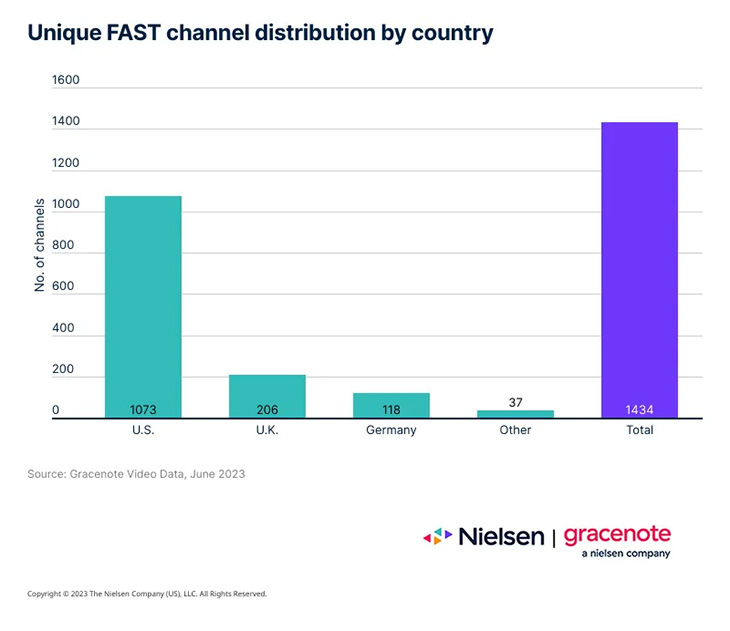FAST channels – also known as free ad-supported television – are aptly named. The entire business has sprung up in just the last decade, and there are now more than 1,400 such channels in existence, according to Nielsen. More than 1,000 of those are U.S.-based, with 206 in the U.K. and 118 in Germany.

Three European executives gathered to discuss the nascent FAST channel business during Promax’s Festival of Virtual Content on Wednesday, during a panel moderated by The Local Act’s Marion Ranchet.
While FAST channels are distributed over the internet (also known as over the top or OTT), their closest relatives are linear broadcast channels. Viewers watch what’s playing at the time of tune in, unlike when they watch streaming video on demand (SVOD) services, when they can select what shows they want to watch.
In a world with ever-increasing subscription prices and too many content choices, FAST channels are seen as a sort of a relief to many viewers. If they just want to watch reruns of Baywatch, there’s a channel for that – no choosing necessary—and it’s free.
Asked who’s watching FAST channels, “everyone,” said Jesper Dahl, vice president and general manager, Pluto TV, Central and Northern Europe. Pluto TV was one of the earliest players in the FAST channel game, having launched in 2014 and then being acquired by ViacomCBS – now Paramount Global – in January 2019.
“On Pluto, we see both young people who love reality TV but also folks who want to watch documentary or legacy shows that they have seen before. We have a very broad group when we do our measurements,” said Dahl.
People also tend to watch FAST channels in much the way they’ve always watched TV – on their living-room couches.
“Most watching is happening in the living room in the evening during primetime,” said Teresa López, co-founder and CEO, Barcelona-based Love TV Channels. Love TV Channels so far includes three: Trailers, Love Wine and Love the Planet.
FAST channels are relatively easy to build once the content is in hand, which is why so many companies with large libraries have launched them. They are advertising-supported, allowing companies to gather some ancillary revenue from their library fare.
“We take a four-pillar approach to launching FAST channels – content, platform, technology and monetization,” said Valerio Motti, vice president, FAST channels, Fremantle. Fremantle has used its vast library to build several FAST channels, including game-show focused channel Buzzr in the U.S.
“The most important thing is to have the right content. Once you have that, you need to talk to platforms. There are different commercial conversations you need to have with the platform before agreeing to go forward.”
A technology provider allows the content to be delivered to the platform. “Without a tech partner, you just have the content and nothing happens,” Motti said.
Once all of that is in place, content providers can focus on monetization. That typically derives from one of two business models, Motti said: revenue share or inventory share. If the agreement is a revenue share, the provider likely sells the advertising and gives the distributor a split. If it’s an inventory share, both the content provider and the distributor are selling advertising in the content.
Bigger companies – such as Paramount Global-owned Pluto TV or RTL Group-owned Fremantle – have an advantage when it comes to advertising sales because they already have teams in place around the globe.
“Pluto is part of Paramount, which is a huge company with a huge ad-sales department and they still have a lot of linear networks,” Dahl said. “We also work with a lot of programmatic partners across the world and we have partnerships with local broadcasters.”
The business of FAST channels is new enough, however, that there are no set business models and innovation is welcome.
“At Fremantle, we believe it makes sense for us to use different business models according to the country or the platform where it makes sense. According to where you are doing business, that will shape the business model,” Motti said. “Flexibility is key.”
That flexibility is one of the fun things about FAST channels. They can be built quickly – allowing for pop-up FAST channels that just exist to support certain events. For example, Pluto TV teamed with a local music festival in Denmark to promote the event, erecting a FAST channel that played music videos and other content relevant to the festival’s talent, driving awareness for the event, the FAST channel and the platform.
Similarly, Fremantle hosted a taco truck in London’s King’s Cross that was manned by chef and food star Jamie Oliver as he promoted the launch of his FAST channel.
“People could eat free tacos, sip free drinks and peruse cookbooks while they experienced Jamie Oliver cooking,” said Motti.
While it’s relatively easy to launch FAST channels, they still need to be supported by marketing if viewers are going to find them, especially in an environment that’s so saturated with content.
“It’s important that the marketing and content are completely aligned on what is good content that can be promoted and what can work on FAST,” said Dahl. “Data is very important. We can see what users like this kind of channel as well as what else they might like.”
Marketing is especially important for smaller channels, like Love TV, because viewers are less familiar with that content. “We are making a selection of content based on a theme so we need to remind the viewer what channel they are watching,” said Lopez.
FAST channels take linear TV and gives it a modern twist.
“We are doing something very new that is replicating a model that is very old,” said Lopez. “It’s an exciting, growing opportunity. It’s the future of TV.”
Tags: fast channels festival of virtual content fremantle love tv pluto tv the local act













































__twocolumncontent.jpg)











